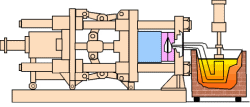The Process of Hot Chamber Zinc Castings. In the hot chamber zinc casting procedure, slabs of zinc are melted inside a furnace with a temperature of approximately 700-800 degrees Fahrenheit. When liquefied, the zinc metal stays in the furnace. The gooseneck or shot sleeve is immersed in the hot chamber and the molten zinc is pushed into the two die halves being held together by the machine. The two halves of the die casting molds are mounted on the die casting machine and the machine turns off and presses the two die halves together. The molten zinc metal is under high pressure until such time that the metal hardens (approximately less than a minute). Die halves then open up and the part or parts are removed and taken out either manually or automatically. Finishing works include trimming, tumble deburring, precision machining, painting, anodizing, chrome plating and assembly.
Hot chamber zinc casting machines are used primarily for zinc, lead, magnesium, copper and other low melting point alloys that do not easily corrode metal furnace pots, plungers and cylinders. The injection mechanism of a hot chamber zinc casing machine is saturated in the molten metal bath of a metal holding furnace. The furnace is attached to the machine by a metal feed system called gooseneck or shot sleeve. As the injection cylinder plunger travels upward, a port in the cylinder opens, allowing hot molten metal to penetrate into the cylinder. As the plunger moves downward, it closes the port and injects molten hot metal into the gooseneck and nozzle into the die cavity. When the metal has already hardened in the die cavity, the plunger is detached, the die opens and the casting is removed.
Die Casting Zinc Company Blog gives information on how to get a zinc die casting part for manufacturers. If you are looking for Die Casting Zinc Parts or if you need Miniature Zinc Die Casting Parts will give you more information you can use for manufacturing.


